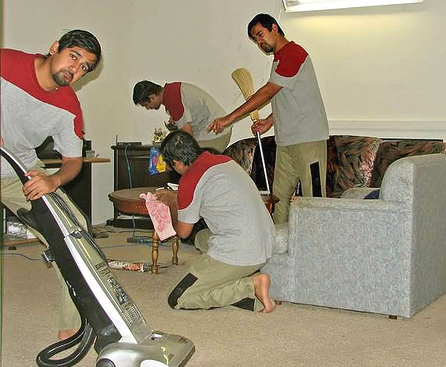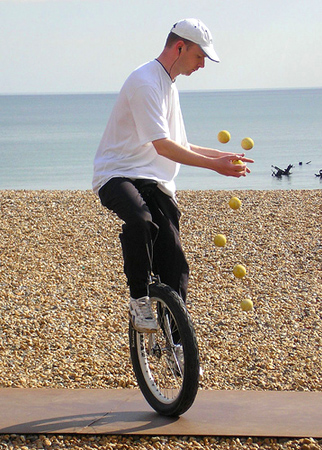
Blogger Dr. Grasshopper, who practices internal medicine in a large urban hospital, posted this today: “Why Your Doctor Comes Across As An A**hole.” Does your doctor seem uninterested in you? Do you feel hurried out of the examining room? Do you ever feel like your big concerns are being brushed aside? Dr. Grasshopper’s post and the article it strongly recommends (“Neuron overload and the juggling physician” in The Lancet) help shed light on issues you and I might not have considered before. They also cover some interesting points about what needs to be fixed in our health care system. They’re the kind of thing practically anyone could benefit from reading in terms of understanding more about their health, their insurance, and their health care providers.
How we’re like doctors
But I have an additional reason to point to the Lancet article in this post, and it’s that many of us have the same problem those doctors do: too many things to juggle with a brain that is designed to only ever juggle one thing at a time.
In my post “How to Multitask, and When Not To” from a couple of years back, I talk about neuroscientist John Medina’s observations on how attention and focus work. His two key points are:
- We can only focus our attention on one thing at a time, and
- Every time we change our focus, we have to do extra work, and we increase the likelihood that we’ll make an error.
For example, if you’re studying from a textbook while sorta-watching a TV program in the background, then you’re creating constant interruptions as your attention moves back and forth. Every time you start paying attention to the program, your brain has to shut down everything you were thinking about what you were reading and then fire up pathways that relate to the TV show. When you look back to the book, the process has to happen again in reverse, but with a good chance that some of the pieces you had in your head a moment ago won’t be included in the re-activation and will be lost.
The benefits of single focus
Even if you only pay attention to 10 minutes of TV during an hour of studying, the number of times you go back and forth between those two things will make your studying much, much less efficient. It’s much better to study for a solid block of time and then watch TV for a solid block of time: you’ll remember more and still have more time to pay attention to the TV show (if that’s what you want to do with your time).
OK, most of us reading this already know that watching TV while studying doesn’t work well. The reason this applies to so many of us is that the same thing is true for any situation where we’re trying to give attention to two things at once–like trying to figure out what to do about a scheduling conflict over the weekend while composing an e-mail at work. It gets even worse when our attention is distracted by many different things.
An example
This is what can sometimes happen to me: I’ll be working on a computer task (for example), be distracted by a new thought about a writing project, realize I need to arrange something for one of the kids, then recall I still haven’t returned a friend’s phone call, then remember that I was supposed to be working on the computer. Each change of focus comes with an inefficient changeover of my mental setup, and the whole process is likely to be enhanced by stress at having so much to worry about and guilt at not getting more of these things done. What’s worse, I may not be staying with any of these tasks long enough to make actual progress.
How not to fall into this trap
The solution is a good organizational system that’s always kept up to date (so that you don’t have to worry about whether or not there’s something in it that you haven’t checked or updated recently) and setting up tasks one after the other, never intermixed if you can help it. (See my post “Useful Book: Getting Things Done” for what I suggest is the gold standard for organizational systems.) If you add to that organization and focus a habit of getting rid of tasks and distractions that aren’t important in your life–or at least getting comfortable with giving them such a low priority that you understand they may never get done–then you have an approach that can yield a much calmer, more productive, and happier day-to-day existence.
Will this help doctors? Maybe not. After all, the problem doctors face is that they’re required to do more work than they can do effectively and at their highest level of skill. Insurance companies and related forces prioritize doctors’ practices. Fortunately, most of us are the ones prioritizing our own lives.
Photo by lovefaucet




 But it’s easier for me than for my son, because I’ve been folding clothes for decades, while my son has only been doing it for a few years. Several times every folding session, I’ll notice he’s stopped folding, his attention fully on the movie. Usually this happens with a trickier item of clothing or with a particularly gripping part of the movie. Not being as used to folding as me, he can’t do it entirely on automatic, so his brain needs some of his attention for the folding, and his attention is already taken up by the movie. Since he can’t pay attention to two things at once, the clothes folding just stops, and since he was doing it automatically, he may not even notice: he may just sit there holding the shirt, transfixed.
But it’s easier for me than for my son, because I’ve been folding clothes for decades, while my son has only been doing it for a few years. Several times every folding session, I’ll notice he’s stopped folding, his attention fully on the movie. Usually this happens with a trickier item of clothing or with a particularly gripping part of the movie. Not being as used to folding as me, he can’t do it entirely on automatic, so his brain needs some of his attention for the folding, and his attention is already taken up by the movie. Since he can’t pay attention to two things at once, the clothes folding just stops, and since he was doing it automatically, he may not even notice: he may just sit there holding the shirt, transfixed.